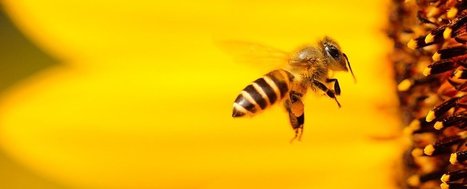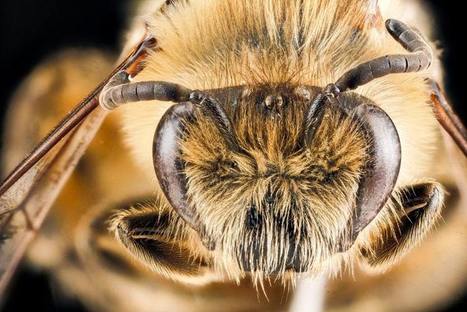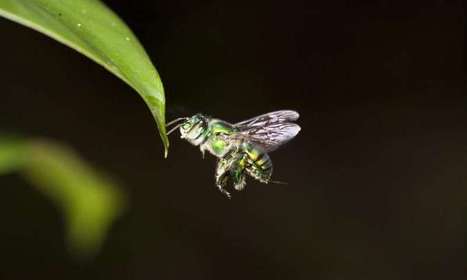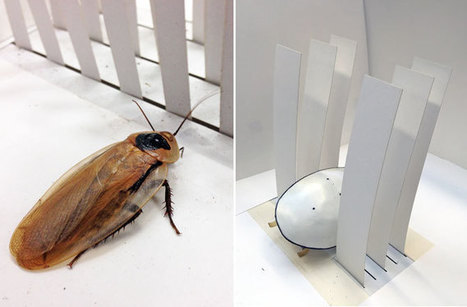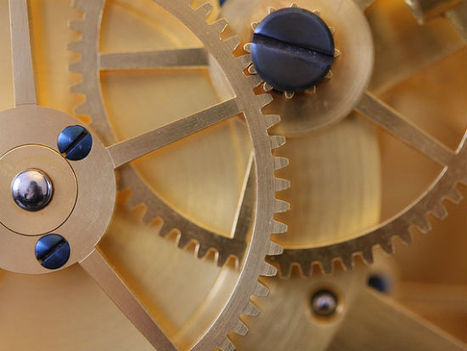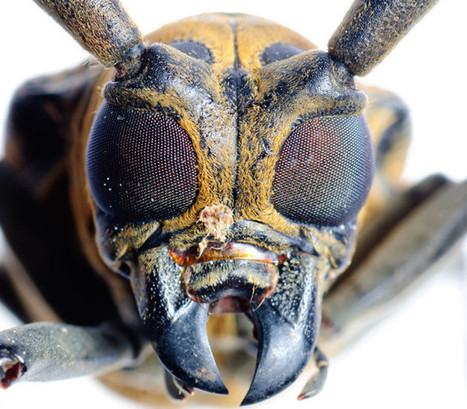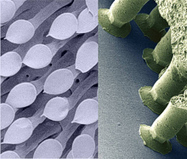 Your new post is loading...
 Your new post is loading...
"The wing of an earwig is a lot like origami—but its elaborate design is far more ingenious than anything humans can make. Researchers have been studying the secret of these wings and have created an artificial structure that functions on the same principle.
When open, the earwig wing expands ten times larger than when closed—one of the highest folding ratios in the animal kingdom. The large wing area allows the insect to fly, while the compact way the wings retract enables the creature to tunnel underground without damaging its wings. The wing design has another unique feature; however, in its open, locked state the wing remains stiff with no need for muscle power to provide stability. With just one “click” the wing folds into itself completely, without the action of muscles."
"New research on how bees perceive colour could be put to good use in our digital cameras, meaning photos shot by drones or phones would look more natural than ever. It's all to do with colour constancy, the way that bees (and humans) can tell a flower is red no matter what the colour or quality of the light – a mental trick that the digital cameras of today really struggle with."
Kazuya Saito (University of Tokyo) and colleagues used high-speed video to watch a ladybird fold its wings. “They found that prominent veins along the edge of the wings allow creases to form and fold the wings away in a complex, origami-like shape. A bend in the wing can drift down a vein as it gets folded, but the wing is ready to spring back to a rigid form when the elytra [i.e. wing cases] open”, New Scientist explains. The wing frames do not have any joints. The NS article also suggests a biomimicry dimension. This “folding mechanism could help us build solar array paddles that unfold themselves in space, foldable wings for small vehicles, or even lead to better umbrellas.”
"The team of architects Maryan Fazel and Belinda Ercan, from Iran and Germany, respectively, have won first prize in the competition for the design of the Moscow Circus School launched by the Architectural Competition Concours d’Architecture (AC-CA).
The winning proposal, entitled Elytra, is an “eye-catching, cutting-edge, [and] unconventional” design that will tower over Moscow’s Tverskoy District, an area which features a burgeoning artistic scene. Inspired by the forewings of insects—called elytra—the project opens upwards as a protective shell, and will feature both public and private space."
"Spend a summer in the countryside in a warm climate and you’ll likely hear crickets chirping, males of the species “singing” in an attempt to attract a female. What’s surprising is how small the creatures are given the very high sound levels they produce. Could studying crickets allow us to learn something about how to design a small speaker that is also loud, just as you need for a hearing aid?"
"Spider's silk is as strong as steel, lighter than carbon fibre and tougher than Kevlar. Several research groups are hoping harness these remarkable properties by creating synthetic versions of the material. Now, North Face has partnered with one of these teams to create a jacket made from a fiber named 'Qmonos' – the Japanese word for spider."
"Scientists have developed a tiny robot - based on the water strider insect - that can jump on water. The robotic version uses the same forces to jump as the water strider - pushing off without breaking the surface. It takes off with a downward force that never exceeds the surface tension of water - the force that "glues" surface water molecules together."
"The German automation giant unleashes a swarm of new robotic insects. [...] The theme of Festo’s “Bionic Learning Network” program this year is “Join the Network,” and their flagship projects are both based around swarms of small robots that mimic the way insects work together and interact with each other."
"Making curved shapes on a 3D printer often involves laying down support material which has to be cut away and disposed of at the end. Printing the support material adds to the cost, slows the process down, generates waste and results in additional work to finish the component where the support has been cut away. The DPG team decided to investigate ways of developing self-supporting printed structures as part of a continuing project to design and develop a fixed wing Unmanned Aerial Vehicle, or UAV. Designers used fractal mathematics, which generates repeating patterns, to create an intricate internal structure for the wing, resembling that of an insect, where repeating patterns of veins strengthen the wing, while allowing its surface to remain flexible." Photo details: "Ischnura senegalensis October 2007" by Laitche. Licensed under Public Domain via Wikimedia Commons.
Caltech researchers uncover a mechanism for how fruit flies regulate their flight speed, using both vision and wind-sensing information from their antennae.
"Insects don’t have the capacity to reason, and yet some are capable of building complex structures and executing complex foraging expeditions with no central organizing. That’s why researchers recently sent ants to the International Space Station and will observe how the change in gravity affects the ants’ ability to organize. At Harvard, scientists are taking their inspiration from termites, which can spend generations building mounds that stretch multiple feet into the air. On Thursday, a research team revealed a crew of iPad-sized robots that can build structures with no input from a central leader."
"Entomologists study insects known for their hard exoskeletons, jointed appendages, segmented bodies, bilateral symmetry and antennae. But perhaps the most impressive part of an insect is its lateral compound eyes. Scientists wishing to study insects have over 1 million species to select from! Insect eyes are so impressive scientist and researcher John Rogers of the Science Research Group at Urbana-Champaign, University of Illinois, is designing miniature drones cameras based on their unique design. The big challenge for engineers is to build a drone camera with a 180° range of vision and clear vision throughout that line of sight. Insects have this ability when born."
"One example of biomimicry that keeps popping up on the pages of Gizmag is the use of insect eyes as a model for innovative new optical devices. It seems that the potential for development in this area is far from exhausted with the announcement of another bug-inspired lens breakthrough from Ohio State University. This experimental lens developed by associate professor of biomedical engineering and ophthalmology, Yi Zhao, combines the wide angle properties of insect vision with the depth-of-field capabilities of a human eye."
|
Scientists at the USA’s Stanford University have looked at the eyes of insects to create the newest form of solar cells. They have discovered that packing tiny solar cells together could pave the way for a new generation of advanced photovoltaics.
One area where biomimicry is yielding fascinating results is in the field of optics and machine vision. While our cameras and ways of thinking about sight have largely been informed by the human visual system, cutting-edge research is looking to insects to find new tricks for everything from depth perception to colour analysis.
"Wind turbines produce 4% of the planet’s energy, but they only work well when the wind is blowing just right. Now, by drawing inspiration from the flexible wings of insects, scientists have found a way to make wind turbine blades 35% more efficient at producing energy. If commercialized, the advance could make this green technology a more viable alternative to fossil fuels in the coming years."
"It only takes a brief journey down a B road during the summer months to end up with a car looking like it has driven through a plague of insects. Amplify this effect by the power of a space shuttle wingspan and bug remnants can result in a significant increase in drag. The problem is that when an insect hits an aircraft at speed its mass ruptures and undergoes some chemical changes which make it stickier. Flying through a swarm of insects leads to an accumulation of debris on the leading edge of wings which creates drag and increases fuel consumption. NASA researchers, in collaboration with engineers at Langley and Boeing, studied the microscopically-rough texture of lotus leaves in order to understand how the surface is so effective at repelling dirt, dust and water."
"After studying how insects navigate through dense vegetation, researchers at Lund University in Sweden have come up with a system that can be applied to flying robots. By adapting the system to drones, they can be made to adjust their speed to their surroundings and fly on their own- completely without human intervention and control. The breakthrough was made by vision researchers Emily Baird and Marie Dacke at the Department of Biology in Lund. Among other things, their research shows how bees that fly through dense forests assess light intensity to avoid other objects and find holes in the vegetation to enable them to navigate safely."
"When you look at a spider web in the garden, one thing is often noticeably absent: the spider. This may be because it is lurking away from the web in a 'retreat', where it can monitor web vibrations through a proxy known as a signal thread. A new Oxford study published in Journal of the Royal Society Interface looks in more detail at the composition and structure of these signal threads, which spiders can use to tell whether they've caught new prey. [...] 'Learning from nature, signal threads could provide inspiration for the development of new remote sensing technologies."
"While researchers hope this robot won’t be crawling around your kitchen floor, they do think a new cockroach-inspired bot will be able to slip through tiny cracks to find people buried in the rubble of collapsed buildings. Dubbed “veloci-roach,” the crawling device uses sensors and locomotion like many other bio-inspired devices. But this one flips on its side to shimmy through spaces that would normally prove too small..."
"Almost anything that flies, be it a plane, a spacecraft, or a drone, has an inertial navigation system with accelerometers and gyroscopes that control yaw, pitch and roll, and thus the flight path. Flying insects like bees, however, don't have inertial systems to guide them; they rely exclusively on what they see. This has inspired two researchers at the Aix-Marseille University in France to build a drone that imitates the way these insects navigate. Their mission was to design it to fly and circumvent obstacles by relying solely on visual cues. "
"Issus coleoptratus is an unlikely hero, but one whose jumping prowess could revolutionize ballistics and spring-loaded machines. [...] In Science, Malcolm Burrows and Gregory Sutton (of the University of Cambridge and University of Bristol, respectively) describe a mechanism on the hind legs of a jumping insect that can only be described as a gear, cogs and all. Although the structure had been seen before, their investigation of its action, using high speed cameras, has revealed its function: the first known case of an intermeshing gear mechanism that was not cast or forged, but that had evolved."
Brains are the most powerful computers known. Now microchips built to mimic insects' nervous systems have been shown to successfully tackle technical computing problems like object recognition and data mining, researchers say.
Nature spent millions of years perfecting flapping-wing flight. Now engineers can reproduce it with machines.
"Adhesion is an extremely important factor in living nature: insects can climb up walls, plants can twine up them, and cells are able to adhere to surfaces. During evolution, many of them developed mushroom-shaped adhesive structures and organs. Lars Heepe and his colleagues at Kiel University have discovered why the specific shape is advantageous for adhesion. The answer is in homogeneous stress distribution between a surface and the adhesive element. [...] The findings of the study made in Kiel can be used for further development of glue-free adhesive surfaces with enhanced performance."
|





 Your new post is loading...
Your new post is loading...


